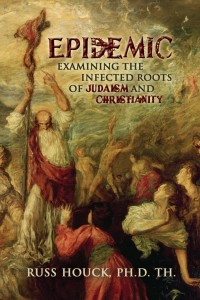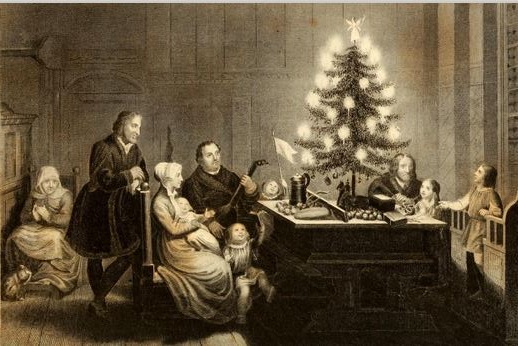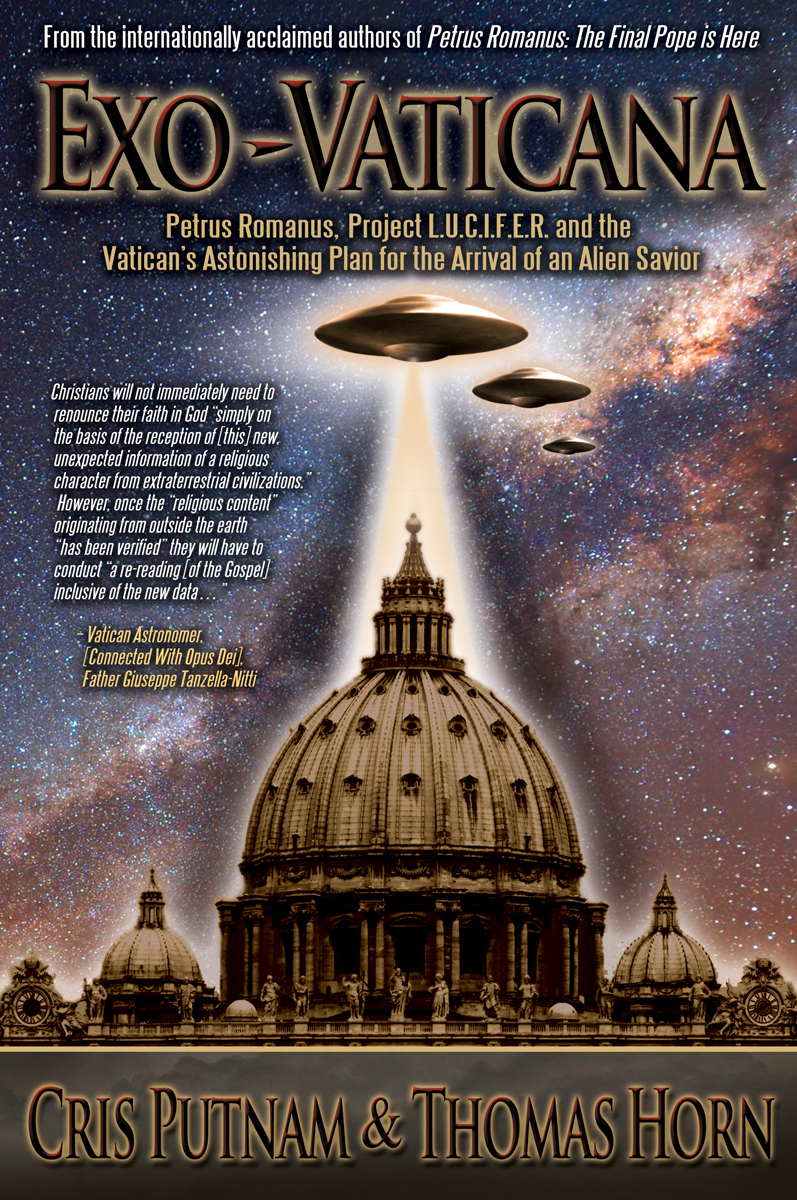The work of Dr. Peter Jones at truthXchange has become highly influential on the conclusions of my current book project The Supernatural Worldview. According to Jones Romans 1:25 allows for only two religions based on the creator/creation distinction or lack their of. In this way two options emerge oneism (all is one, pantheistic monism) and twoism (theism including a transcendent Creator). This simplifies a great deal and makes a great starting point in worldview analysis. The video below is a brief introduction to the concept.
Only Two Religions — Oneism or Twoism — Where do you stand?
Christmas Trees Are Not Pagan!
By Cris Putnam
Christmas is certainly not pagan. Sure, Jesus’ birth was probably in the Fall rather than December but the exact day is uncertain. Even so, Christmas is the celebration of the savior’s birth because that is when most all Christian churches celebrate. While some customs have a distant pagan origin, the idea that Christmas trees are pagan is almost certainly false. Jeremiah 10 describes fashioning Canaanite idols from fresh cut wood and precious metals. It has nothing to do with Christmas trees. There have been a myriad of customs in different cultures using holly and evergreen but there is not a discernable evolution from paganism to today’s Christmas tree from the ancient world. Christianity relegated pagan belief to the cultural dustbin and tree customs were sporadic and divergent until after the reformation. The modern tree began in sixteenth century Germany. The best evidence points to Martin Luther for popularizing the candle lit evergreen tree.[i] As the reformation spread, so did Luther’s legacy. A popular artist, Carl Schwerdgeburth, painted a scene of Luther’s family around a candle-lit tree:
Painting source[ii]
This painting, depicting what oral tradition indicated happened in 1536, was engraved in a gift book titled Wheat Sheaf from 1853 that was published in Philadelphia. It also said that Luther was the first to light a tree with candles in order to illustrate the “light of God” to his children.
Because Luther was a great advocate of Christmas, the Christmas tree became a sign of Protestant solidarity and German nationalism. The Catholic majority of the lower Rhine discouraged the lighted tree as a Protestant custom. In the early nineteenth century, lit trees gained widespread acceptance across Germany.[iii] Most likely, the tradition came to the United States with Hessian troops during the American Revolution and/or the German immigrants to Pennsylvania and Ohio.
Many have pointed out the New England puritans did not recognize the holiday. However, their reasoning for disdain was not its alleged pagan origins but rather a form of strict biblicism that asserted that if a holiday is not in scripture it should not be celebrated. Not many folks still agree that conclusion is scriptural because it is inconsistent with our freedom of conscience in Christ (Col 2:16). Because we are not under Israelite ceremonial law, we are free to celebrate the birth of the savior any day we please! Finally, it is safe to say, that hardly anyone is thinking about pagan deities while performing Christmas traditions. Most of the conspiracy theories give paganism too much credit. Paganism did not infect Christianity but rather Christianity made paganism irrelevant.
[i] Karal Ann Marling, Merry Christmas! Celebrating America’s Greatest Holiday,( Boston: Harvard University Press, 2009), 176.
[iii]Johannes Marbach, The Holy Christmas season for meaning, history, customs and symbols (Stutgart: 1859), 416. http://books.google.com/books?id=FXhEAAAAcAAJ&pg=PA416#v=onepage&q&f=false
Charlatan Ergun Caner Hired by Brewton-Parker College
The secularist website Right Wing watch published this:
If you were the trustee of a troubled college fighting to keep its accreditation, would you hire as your new president someone who was forced out of a previous academic post for lying about his past? That’s what the trustees of Brewton-Parker College in Georgia have just done; the college announced this week that it has hired Ergun Caner to be its new president. –See more HERE
Its not that I believe Right Wing Watch is a fair source but rather how Caner’s continued lies are disgracing Christianity. If you have any doubt about it please watch this presentation by Dr White. As a former LBTS student, I would have preferred to defend Caner but his actions are indefensible and his recent claims of exoneration are so absurd they show he has never acknowledged his dishonesty much less repented.
Russ Houck’s Epidemic: Heretical Pseudohistory
By Cris D. Putnam
 Throughout history, cults have fed off of the periphery of Christianity. Because a large part of evangelicalism is now preaching a seeker sensitive message, those hungry for real biblical truth and depth are easy prey for pseudo-scholars writing revisionist history like Russ Houck. The book under review, Epidemic: Examining the Infected Roots of Judaism and Christianity belongs to the genre of Pseudo-history.
Throughout history, cults have fed off of the periphery of Christianity. Because a large part of evangelicalism is now preaching a seeker sensitive message, those hungry for real biblical truth and depth are easy prey for pseudo-scholars writing revisionist history like Russ Houck. The book under review, Epidemic: Examining the Infected Roots of Judaism and Christianity belongs to the genre of Pseudo-history.
“It purports to be history, and uses ostensibly-scholarly methods and techniques (which in fact depart from standard historiographical conventions), but is inconsistent with established facts and/or with common sense. It often involving sensational claims whose acceptance would significantly require rewriting accepted history.”[1]
Lacking footnotes and substantive documentation, Epidemic is a poorly researched book that will appeal largely to marginalized members of society. However, that is what makes it so very dangerous. Houck makes a seductive appeal from emotion and incredulity that depends on the reader’s historical and theological ignorance. The charge of Pseudohistory will be proven beyond a reasonable doubt in this essay.
Houck makes radical unsubstantiated claims without any evidence. For example, he claims that Constantine completely corrupted the New Testament and infected Christianity. If what Houck writes it true, then one cannot trust anything in the New Testament to be genuine, not even the great commission. When a passage like Matthew 28:19 “Go therefore and make disciples of all nations, baptizing them in the name of the Father and of the Son and of the Holy Spirit” (Mt 28:19) disagrees with his Anti-trinitarianism, Houck constructs a conspiracy theory to dismiss the passage. Because the book is over four hundred pages of pseudo-history and conspiracy theory; for the purpose of this review only four major points are examined.
He claims 1) the trinity is a pagan doctrine inserted by Constantine; 2) Constantine added Matthew 28:19; 3) The earliest MS of the NT do not contain Matt 28:19 the Great Commission. 4) The original NT was all in Hebrew or Aramaic– Constantine changed it to Greek. After these four point are shown to be false two major heresies will be shown, denial of the Holy Spirit and Arianism (the belief that Jesus was birthed from the Father).
For Houck to make a case he needs to show some relationship between paganism and trinitarianism but he has not done so. There is no deity in Greco-Roman paganism who is one in essence and three in person. He does not show a single source document from paganism with the concept of trinity. In fact, a central argument used by real theologians is the Trinity’s absolute uniqueness amongst world religions. Millard Erickson writes in his Christian Theology, “In the doctrine of the Trinity, we encounter one of the truly distinctive doctrines of Christianity. Among the religions of the world, the Christian faith is unique in making the claim that God is one and yet there are three who are God.”[2] Although the internet is full of sources citing Alexander Hyslop’s long discredited book The Two Babylon’s, archeologists have uncovered a wealth of information about ancient Babylon. No one has ever substantiated Hyslop’s claims with actual citations from Babylonian literature because they do not exist.
The doctrine of the Trinity is based on three foundational biblical truths: 1) monotheism 2) three divine persons: Father, Son, Holy Spirit, 3) the three divine persons are co-equal and co-eternal. It contains no inherent contradiction. The law of non-contradiction states that something cannot be true and not true at the same time in the same way. If one said, “one in person and 3 in person” then it would be a contradiction. There is no logical contradiction with “one in essence but 3 in person.” For an in-depth defense of the trinity refer to my website here. But Houck’s claim that Constantine initiated this is easily refuted by the early church Fathers.
Early Church Father’s Disprove Houck
The Martyrdom of Polycarp is an ancient account of Polycarp’s (a disciple of the apostle John) death. It reports that Polycarp used the Triune Name in a prayer. He said, “I bless You, I glorify You, along with the everlasting and heavenly Jesus Christ, Your beloved Son, with whom, to You, and the Holy Ghost, be glory both now and to all coming ages.”[3] Also, Ignatius lived in the first century, the time of apostles. The second chapter of his “Epistle to the Philippians” reads “He sent forth the apostles to make disciples of all nations, commanded them to “baptize in the name of the Father, and of the Son, and of the Holy Ghost.”[4] A direct quote of Matthew 28:19. But it gets very specific with Tertullian.
Tertullian, a century before Constantine, writes in On Baptism, “sealed in (the name of) the Father, and the Son, and the Holy Spirit,”[5] citing Matthew 28:19 directly. In the statement of the Trinity, Tertullian (160-225) was a forerunner of the Nicene doctrine of the trinity. Tertullian wrote in Against Praxeus ch. 12: “If the number of the Trinity also offends you, as if it were not connected in the simple Unity, I ask you how it is possible for a Being who is merely and absolutely One and Singular, to speak in plural phrase, saying, “Let us make man in our own image, and after our own likeness; ”[6] Furthermore, Tertullian wrote in Against Praxeus chapter 25: “Thus the connection of the Father in the Son, and of the Son in the Paraclete, produces three coherent Persons, who are yet distinct One from Another. These Three are, one essence, not one Person, as it is said, “I and my Father are One,”[7] Here the term Trinity is explained as three persons in one essence over one hundred years before Constantine. How could Houck miss such and obvious problem for his thesis?
The citations form Ante-nicean (pre- AD 325) church Fathers thoroughly discredit Houck’s claim that Constantine corrupted the great commission. The earliest New Testament manuscripts do as well.
Early Manuscripts Disprove Houck
Houck says Matt 28:19 does not exist in any MS dated earlier than the Byzantine text of Constantine (AD 325). (p. 212) Constantine did not commission any Bibles at the council of Nicea itself. He did commission fifty Bibles in AD 331 for use in the churches of Constantinople, itself still a new city. No historical evidence points to involvement on his part in selecting or omitting books for inclusion in commissioned Bibles. And there is no historical evidence he changed the text. Houck not only claims he changed it , he even claims Constantine was responsible for changing the language to Greek. But we have hundreds of Greek MS dating before Constantine! Our two oldest extant Bibles are Greek and contain Matt 28:19. New Testament scholars Kurt Aland, Bruce M. Metzger, Bart D. Ehrman doubt that the two oldest extant codexs: Sinaiticus and Vaticanus were copied by Eusebius on the Constantine order. They reflect the Alexandrian text type rather than the Byzantine:
The suggestion has been made by several scholars that the two oldest parchment manuscripts of the Bible that are in existence today, namely Codex Vaticanus and Codex Sinaiticus may have been among those ordered by Constantine. … There are, however, one or two indications that point to Egypt as the place of origin of Codex Vaticanus, and the type of text found in both codices is unlike that used by Eusebius.[8] (Houck cites this book by Metzger approvingly on page 226)
Codex Sinaiticus is an early fourth century Alexandrian MS and it absolutely contains the nomina sacra:
19 Go, make disciples of all nations, baptizing them into the name of the Father and of the Son and of the Holy Spirit.”[9]
Vaticanus is also available for examination online[10] and it certainly contains the Trinitarian formula.
By Constantine’s time there were thousands of copies but not a single MS has been found that lacks the Trinitarian formula and, worse yet, not a single church father complained about the addition. We have elaborate transcripts of debates, counsels and disputes over every major doctrine, especially the trinity—yet Houck cannot produce one single reference concerning Matthew 28:19 to back up assertion. However, there are citations in early church documents in favor of its authenticity.
Didache Disproves Houck
Houck draws great significance from the lack of a specific triniatrian formula in the baptismal texts in Acts but NT scholars are in agreement that Acts presents condensed summaries and none of these descriptions were intended to be strict formulas for use in baptism. The early summary of apostolic doctrine, the Didache 7:1–4; 9:5, uses both formulas interchangeably.
7. But concerning baptism, thus shall ye baptize. Having first recited all these things, baptize in the name of the Father and of the Son and of the Holy Spirit in living (running) water. [11]
9: But let no one eat or drink of this eucharistic thanksgiving, but they that have been baptized into the name of the Lord;
On page 152 Houck claims the Didache is a gnostic document but NT scholars and historians do not believe Gnosticism yet existed when it was composed. Houck is grossly misinformed, seeming to believe that Gnosticism dates back before Christ. No historian agrees with him; most scholars place the origins of Gnosticism in the late second century AD.[12] On the Didache, Patristics scholar, J. Tixeront, in the Handbook of Patrology writes:
The dates fixed upon by critics for the composition of the Didache fall between the years 50 and 160. The work was probably composed between 80 and 110. The basis for such a conclusion is the fact that the liturgy and hierarchy which the author describes, are quite primitive; there is no trace in the work of a creed or a canon of the Scriptures, and no allusion is made to pagan persecution or Gnosticism. [13]
Yet Houck is brazen enough to claim it is a gnostic work without substantive argument or evidence. But elsewhere, passages like John 15:25 where Jesus states, “But when the Helper comes, whom I will send to you from the Father, the Spirit of truth, who proceeds from the Father, he will bear witness about me” testify to the likelihood that Trinitarianism has its roots in the teaching of Jesus Himself and argues for the historical probability of the saying in Matthew 28:19.
Even more, the apostle Paul implies the Trinitarian formula in his benediction: “The grace of the Lord Jesus Christ and the love of God and the fellowship of the Holy Spirit be with you all.(2 Co 13:14) and so does Peter: “according to the foreknowledge of God the Father, in the sanctification of the Spirit, for obedience to Jesus Christ and for sprinkling with his blood: May grace and peace be multiplied to you.”(1 Pe 1:2) Did Constantine alter these books as well?
Greek NT Pre-existed Constantine by Centuries
Houck would have us believe the original language of the NT was not Greek, but rather Hebrew. He calls it a papal deception, writing, “Contrary to popular scholarly opinion, I believe there is substantial evidence that the original NT were written in Hebrew and Aramaic with the possible exception of the epistle to the Phillipians.”[14] But the only evidence he cites pertains to Matthew’s gospel – which is hardly controversial. How does he justify the leap from Matthew to the entire New Testament?
He doesn’t.
Houck fails to substantiate his claims that any of Paul’s epistles were not originally in Greek.
Luke who wrote Luke/Acts was a gentile. In Acts 21:40 Luke mentions that Paul addressed them in the Hebrew language – making a distinction. Again in Acts 22:2 he makes the distinction: “And when they heard that he was addressing them in the Hebrew language, they became even more quiet…”(Ac 22:2) The distinction only makes sense in light of the normal language being Koine Greek the commonly used language.
The book of Revelation makes a similar distinction: “They have as king over them the angel of the bottomless pit. His name in Hebrew is Abaddon, and in Greek he is called Apollyon.(Re 9:11) AND “And they assembled them at the place that in Hebrew is called Armageddon.(Re 16:16) If the original language was Hebrew this would not be necessary.
So I ask, how can Mr. Houck make such radical claims that disagree with the author’s own words? Here is a useful chart showing some of the most important examples. How can he explain away the hundreds of Greek manuscripts that predate Constantine? He doesn’t bother.
Historians are well aware that by the first century even most Rabbis used the Greek Septuagint version of the Old Testament because Hebrew fluency was so poor.
Alexander the Great conquered the known world and Greek became the common language for most people. In Egypt, under Ptolemy Philadelphus (285–246 b.c.) the Old Testament was translated into Greek. The appearance of this translation indicated that Jewish residents in Egypt were becoming more proficient in the use of Greek than in the use of their native Hebrew. Jewish tradition taught that this translation was the work of seventy-two Jewish scholars. The translation, known as the Septuagint, is commonly designated by the Roman numerals LXX, since seventy is the nearest round number to seventy-two.
Writers of the New Testament frequently used the Septuagint whenever they quoted the Old Testament. In the time of Christ it was used as a standard text, even by the rabbis. The early Church Fathers also drew upon it. Thus a knowledge of the Septuagint is helpful for all students of Scripture.[15]
Houck needs to explain why most of the NT quotations of the OT are from the Greek version, not the Hebrew, “OT scholar Gleason Archer lists 340 places where the New Testament cites the Septuagint but only 33 places where it cites from the Masoretic Text rather than the Septuagint.”[16]
An example where the Greek gospels quote the Septuagint is Matthew: “Behold, the virgin shall conceive and bear a son, and they shall call his name Immanuel” (which means, God with us).”(Mt 1:23, ESV)
LXX: Because of this, the Lord himself will give you a sign: Look, the virgin (παρθένος) will become pregnant⌋ and will bear a son, and you will call his name Immanuel[17]
.39 παρθένοςa, ου f: a female person beyond puberty but not yet married and a virgin (though in some contexts virginity is not a focal component of meaning)—‘virgin, young woman.’ ἡ παρθένος ἐν γαστρὶ ἕξει ‘a virgin will conceive’ Mt 1:23.[18]
Masoretic: “Therefore the Lord himself will give you a sign. Look, the young woman (almah) is with child and shall bear a son, and shall name him Immanuel.(Is 7:14)
Because almah is not necessarily a virgin, the LXX version is a very important evidence for the virgin birth not supported by the Hebrew version. Houck’s thesis undermines the best evidence for the virgin birth.
Another example that shows decisively the Greek LXX was used because the words do not appear at all in the Masoretic.
Hebrews: “And again, when he brings the firstborn into the world, he says, “Let all God’s angels worship him.”(Heb 1:6, ESV)
LXX: “Delight, O heavens, with him and worship him, you sons of God. Delight, O nations, with his people and prevail with him, all you angels of God. For he will avenge the blood of his sons, and he will avenge and he will repay the enemies with vengeance, and he will repay those who hate, and the Lord will cleanse out the land of his people.’ ”(Dt 32:43, LES)
But the Masoretic Hebrew text does not contain the reference to angels at all!
Masoretic: “Call for songs of joy, O nations, concerning his people, for the blood of his servants he will avenge, and he will take reprisals against his foes, and he will make atonement for his land, his people.”(Dt 32:43, LEB)
Not only was Greek the language of the NT it was the language for OT as well. Houck is grossly uninformed.
Argument Against the Holy Spirit Fails
His main argument against the personhood of the Holy Spirit is as follows:
1) Jesus is described as “the only begotten of the Father” (Jn 1:14, KJV)
2) Matthew 1:18 seemingly gives the Holy Spirit the role of impregnating Mary. “…she was found with child of the Holy Ghost.”( Mt 1:18)
3) If the Holy Spirit is person then Jesus cannot be begotten of the Father but rather the Spirit.
Therefore, “one God in three persons” must be false.
This presumes the Father Son relationship is based on something as mundane as biological procreation and is very close to the Mormon belief that the father physically had sex with Mary. Jesus’ incarnation was a miracle – it was a virgin birth—the Holy Spirit’s personal role would not make him Jesus’ father, the whole line of reasoning is flawed.
Houck’s misunderstanding is due to surface reading of an English translation (and apparently he only checked the KJV). The words “only begotten” comes from the Greek word monogenēs, properly means “one of a kind, unique.” It does not imply sexual procreation as Houck believes: For example, Hebrews 11:17 uses the same word: “By faith Abraham, when he was tested, offered up Isaac, and he who had received the promises was in the act of offering up his only-monogenes– son,”(Heb 11:17) But we all know that Abraham did have another son, Ishmael, and later sons by Keturah, but Isaac was a unique son in that he was a son born as the result of certain promises made by God. Accordingly, he could be called a μονογενής son, since he was the only one of his kind. John 1:14 is more properly rendered “the only Son from the Father.” Modern translations have clarified and corrected the English for greater accuracy. He could have checked the ESV and seen a more accurate rendering: “And the Word became flesh and dwelt among us, and we have seen his glory, glory as of the only Son from the Father, full of grace and truth.(Jn 1:14).
Psalm 2 reveals the Father Son relationship existed before the incarnation; “I will tell of the decree: The Lord said to me, “You are my Son; today I have begotten you.(Ps 2:7) when we turn to Acts 13 we see that the term “begotten” refers to the resurrection not physical birth! “this he has fulfilled to us their children by raising Jesus, as also it is written in the second Psalm, “ ‘You are my Son, today I have begotten you.’’(Ac 13:33)
The Father and Son status is eternal (John 1:1-3). Hebrews 13:8: “Jesus Christ is the same yesterday and today, and forever.” God Himself spoke of the Son in Hebrews 1:8 and says, “Thy throne, O God, is forever and ever.” Jesus has existed eternally; there never was a time when he was not. His argument against the Holy Spirit fails but his misunderstanding of “begotten” has led him into another grave theological error: Arianism.
Houck is an Arian
A theological dictionary defines Arianism as:
Arianism, Arius. An early heretical teaching about the identity of Jesus Christ. Arianism was founded primarily on the teachings of Arius (d. 335/336). The central characteristic of Arian thought was that because God is one, Jesus could not have also been truly God. In order to deal with the scriptural testimony to the exalted status of Christ, Arius and his followers proposed that Jesus was the highest created being of God. So although Christ was fully human, he was not fully God. Arius’s teaching was condemned as heretical at the First Ecumenical Council (Nicaea) in A.D. 325.[19]
Although he will deny it, Houck is an Arian because he believes that the Son is not eternal but was rather birthed out of the Father. He asserts that sometime prior to the creation Jesus did not exist and “came forth from God.”[20] Houck writes that, “the Son was birthed out of the plural Father eons before Mary was born, and before the world was created. Furthermore, He was not created out of anything (or out of nothing) as other celestial beings. He was the only one birthed out of the Father.”[21] He knows Arianism is a serious heresy so he tries to have his cake and eat it too. But it is inescapable that Houck believes in a created Christ. If Jesus is not eternal, he is not fully God. The law of excluded middle applies. If there was ever a time, nor matter how many eons past that he did not exist, he is a created being by definition. How can someone who claims to have a PhD in theology make such obvious errors? The answer is not surprising.
Houck is Unqualified
All of his claimed degrees in biblical studies and theology are from unaccredited internet schools. Even his undergraduate degree is from a school with phony accreditation. He lists a BA in Theology from the School of Bible Theology in San Jacinto, California. What is interesting is that the president of this school is Stephen T. Anderson (see this at http://www.sbtsu.org/
[1] Pseudohistory http://en.wikipedia.org/wiki/Pseudohistory
[2] Millard J. Erickson, Christian Theology., 2nd ed. (Grand Rapids, MI: Baker Book House, 1998), 347.
[3] Chapter 14. The prayer of Polycarp, http://www.newadvent.org/fathers/0102.htm
[4] Ignatius of Antioch, Epistle of Ignatius to the Philippians Chapter II.—Unity of the three divine persons. http://www.ccel.org/ccel/schaff/anf01.v.xvii.ii.html
[5] Tertullian, On Baptism Chapter VI.—The Angel the Forerunner of the Holy Spirit. Meaning Contained in the Baptismal Formula. http://www.ccel.org/ccel/schaff/anf03.vi.iii.vi.html
[6] The Ante-Nicene Fathers Vol. III : Translations of the Writings of the Fathers Down to A.D. 325, Latin Christianity: Its Founder, Tertullian. (Oak Harbor: Logos Research Systems, 1997), 606.
[7]Alexander Roberts, James Donaldson and A. Cleveland Coxe, The Ante-Nicene Fathers Vol. III : Translations of the Writings of the Fathers Down to A.D. 325, Latin Christianity: Its Founder, Tertullian. (Oak Harbor: Logos Research Systems, 1997), 621.
[8] Metzger, Bruce M.; Ehrman, Bart D. (2005). The Text of the New Testament: Its Transmission, Corruption, and Restoration (in English) (4th ed.). New York – Oxford: Oxford University Press. pp. 15–16. http://archive.org/stream/TheTextOfNewTestament4thEdit/TheTextOfNewTestament4thEdit_djvu.txt
[9]Codex Sinaiticus http://www.codexsinaiticus.org/en/manuscript.aspx?book=33&chapter=28&lid=en&side=r&verse=19&zoomSlider=0
[10] Codex Vaticanus, http://www.csntm.org/Manuscript/View/GA_03
[11] Joseph Barber Lightfoot and J. R. Harmer, The Apostolic Fathers (London: Macmillan and Co., 1891), 232.
[12] scholars prefer to speak of “gnosis” when referring to 1st-century ideas that later developed into gnosticism and to reserve the term “gnosticism” for the synthesis of these ideas into a coherent movement in the 2nd century.
[13] J. Tixeront, A Handbook of Patrology http://www.earlychristianwritings.com/tixeront/section1-1.html#didache
[14] Epidemic, 208.
[15] Thomas D. Lea and David Alan Black, The New Testament: Its Background and Message, 2nd ed. (Nashville, TN: Broadman & Holman Publishers, 2003), 15–16.
[16] G. Archer and G. C. Chirichigno, Old Testament Quotations in the New Testament: A Complete Survey, 25-32.
[17]Rick Brannan et al., eds., The Lexham English Septuagint (Bellingham, WA: Logos Bible Software, 2012), Is 7:14.
[18]Johannes P. Louw and Eugene Albert Nida, Greek-English Lexicon of the New Testament: Based on Semantic Domains (New York: United Bible Societies, 1996), 108.
[19] Stanley Grenz, David Guretzki, and Cherith Fee Nordling, Pocket Dictionary of Theological Terms (Downers Grove, IL: InterVarsity Press, 1999), 15.
[20] Epidemic, 382.
[21] Codex Vaticanus





